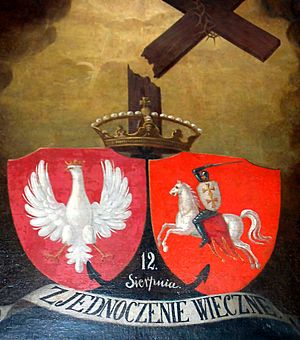Polish-Lithuanian Union facts for kids
The Polish-Lithuanian union was a special agreement that brought together the Kingdom of Poland and the Grand Duchy of Lithuania. It started as a way for both countries to share the same ruler. Over many years, this agreement grew stronger, leading to the creation of a big, powerful country called the Polish-Lithuanian Commonwealth in 1569. This new country was often called the "Republic of the Two Nations." Later, in 1791, there was even an attempt to make them into one single state, but this lasted only a short time.

Contents
Why Poland and Lithuania Joined Forces
Poland and Lithuania decided to unite for several important reasons. One big reason was to protect themselves from common enemies, like the powerful Teutonic Knights. By joining their armies and resources, they became much stronger together. This union also helped both countries grow and develop.
Key Steps in the Union
The union between Poland and Lithuania didn't happen all at once. It was a long process with several important agreements over many years. Each step made the two countries closer.
The First Step: Union of Krewo (1385)
The very first agreement was the Union of Krewo in 1385. This was a "personal union." It meant that the Grand Duke of Lithuania, Jogaila, married the Queen of Poland, Jadwiga of Poland. Because of this marriage, Jogaila became the King of Poland (known as Władysław II Jagiełło). So, both countries now had the same ruler, but they still kept their own separate governments and laws.
Strengthening the Bond: Later Unions
After the Union of Krewo, Poland and Lithuania signed several more agreements to make their connection stronger. These included:
- 1401 - Union of Vilnius and Radom: This agreement helped confirm the personal union and set up how the two countries would work together.
- 1413 - Union of Horodło: This union made the ties even tighter. It allowed Polish nobles to adopt Lithuanian nobles into their families, helping to create a shared culture among the ruling classes.
- 1432 (1432-34) - Union of Grodno: This agreement further strengthened the political and military alliance between the two states.
- 1499 - Union of Kraków and Vilnius: This union focused on mutual defense and cooperation against common threats.
- 1501 - Union of Mielnik: This agreement aimed to create an even closer political bond, though it wasn't fully put into practice.
The Big Union: Union of Lublin (1569)
The most important step was the Union of Lublin on July 1, 1569. This agreement created the Polish-Lithuanian Commonwealth, also known as the "Republic of the Two Nations." It was much more than just having the same ruler. Both countries agreed to have:
- A single ruler (who was elected by nobles from both Poland and Lithuania).
- A shared parliament (called the Sejm).
- A common foreign policy (how they dealt with other countries).
- One currency (money).
- No customs borders between them, making trade easier.
Even though they shared these things, Poland and Lithuania still kept some of their own laws, armies, and government offices. It was a unique partnership that lasted for over 200 years.
The Final Attempt: May 3 Constitution (1791)
On May 3, 1791, a new constitution was passed in Poland. This Polish Constitution of May 3, 1791 tried to make the Commonwealth even more unified. It aimed to get rid of the separate Kingdom of Poland and Grand Duchy of Lithuania and create one single, "unitary" state. However, this change was very short-lived. Soon after, the Commonwealth faced invasions from neighboring countries, and it eventually disappeared from the map.
The Polish-Lithuanian union was a remarkable historical process that shaped the history of Eastern Europe for centuries.

